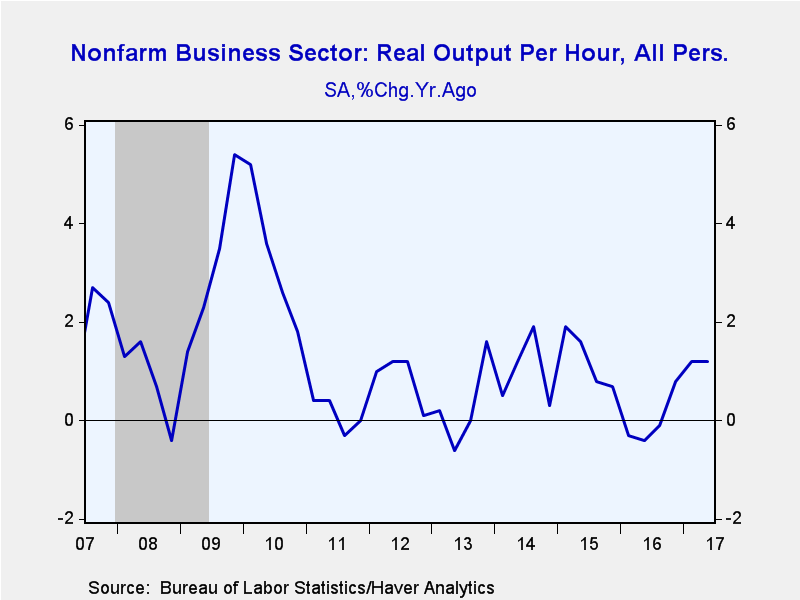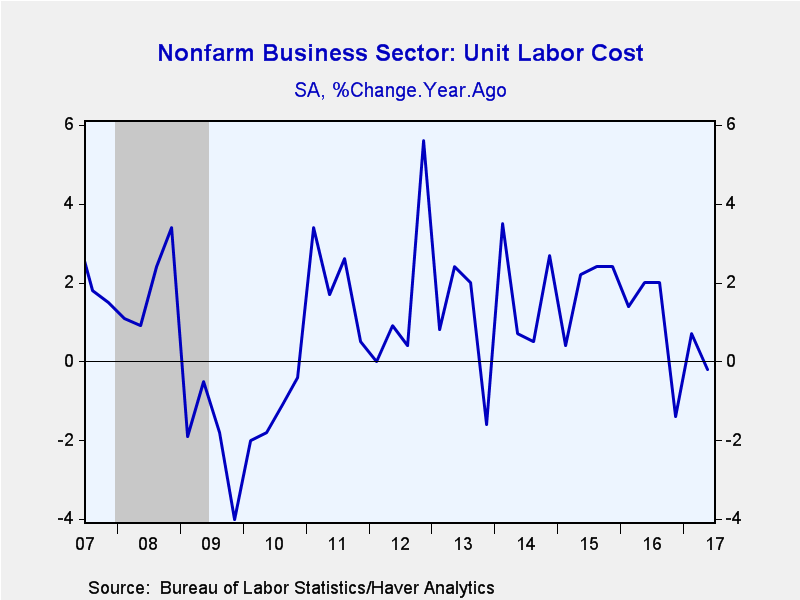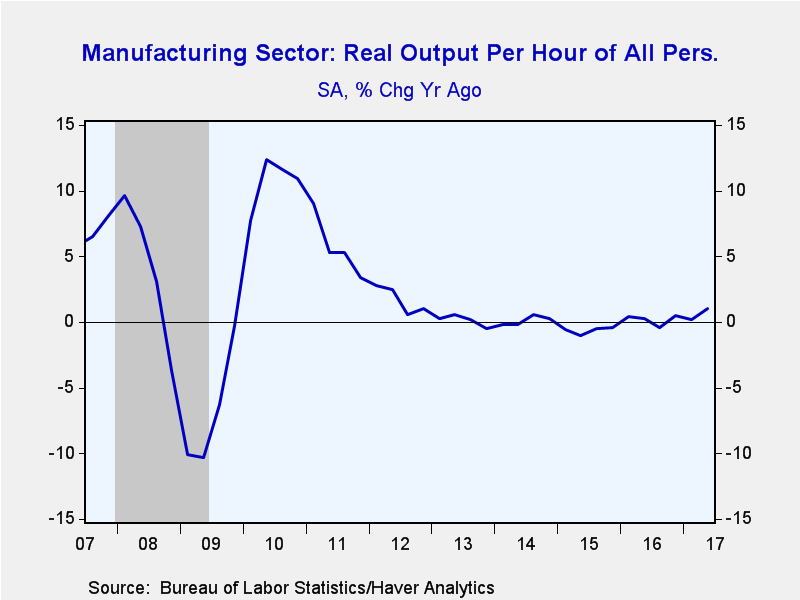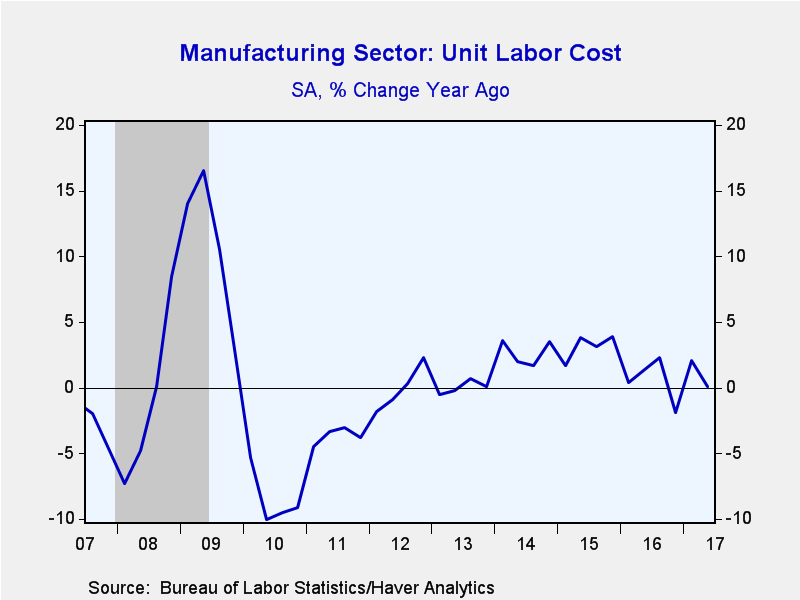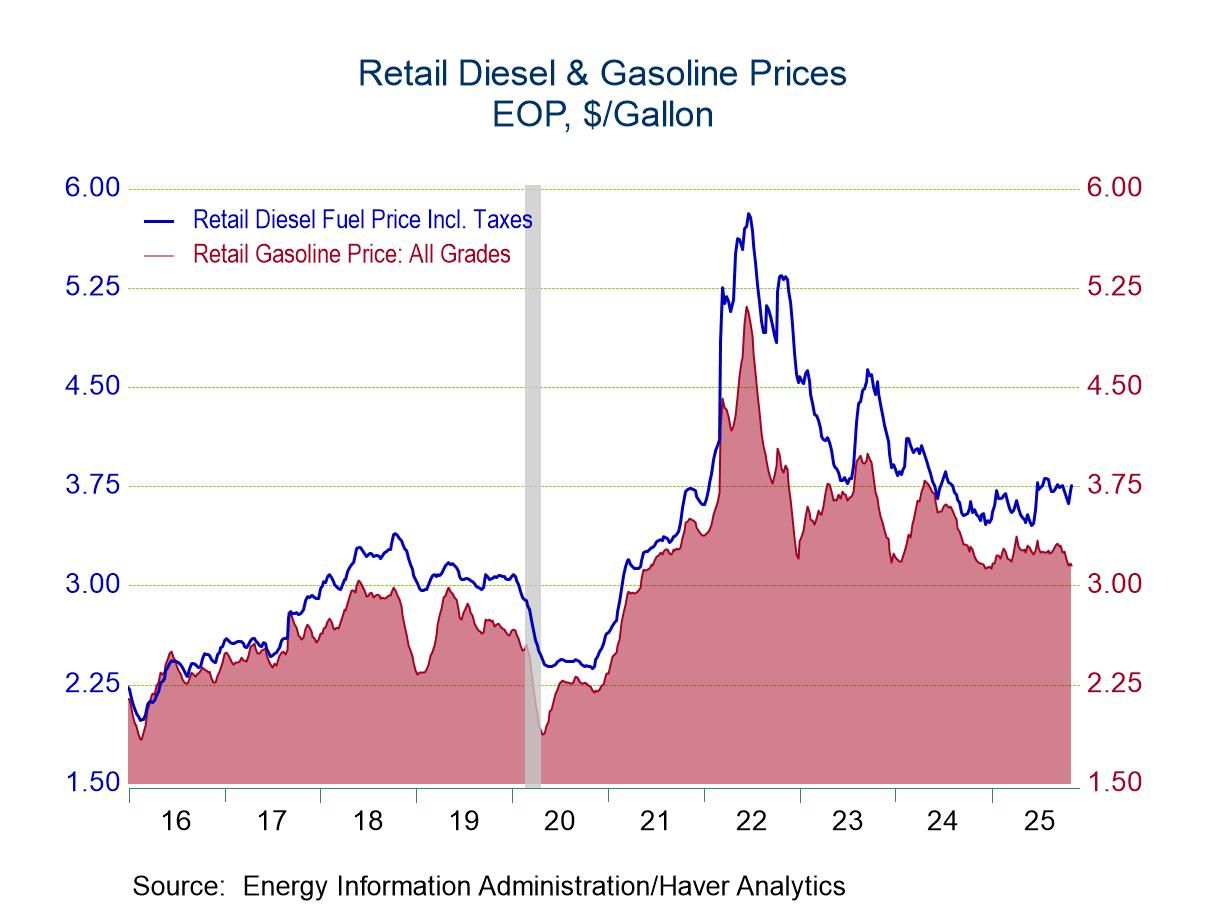 Global| Aug 09 2017
Global| Aug 09 2017U.S. Productivity Picks Up While Cost Pressures Ease
by:Tom Moeller
|in:Economy in Brief
Summary
Output per hour in the nonfarm business sector improved at a 0.9% annual rate in the second quarter following a 0.1% uptick in the first quarter. A 0.7% rise had been expected in the Action Economics Forecast Survey. Output rose 3.4% [...]
Output per hour in the nonfarm business sector improved at a 0.9% annual rate in the second quarter following a 0.1% uptick in the first quarter. A 0.7% rise had been expected in the Action Economics Forecast Survey. Output rose 3.4% (2.7% y/y) while hours worked increased 2.5% (1.5% y/y). The modest gains during the last two quarters left y/y growth in productivity at 1.2%. During all of last year, however, productivity declined 0.1%, revised from the earlier estimate of a 0.2% advance. Growth during 2015 was revised up to 1.0% from 0.8%. On average, during the last five years there has been 0.7% growth in worker productivity, slower than 1.8% growth during the prior five years and reduced from 2.8% in the five years before that.
Unit labor costs increased 0.6% last quarter following a 5.4% Q1 rise. A 1.5% gain had been expected. During the last four quarters, unit labor costs declined 0.2%, down from last year's 1.0% rise. During the last five years, annual growth increased an average 1.5% per year. Compensation costs increased 1.6% last quarter after a 5.5% rise. Four quarter growth of 1.0% compared to 0.9% last year and 2.2% during the last five years.
In the manufacturing sector, productivity rose 2.5% last quarter following a 0.3% rise. Growth during the last four quarters of 1.0% was improved from the 0.2% gain in 2016. During the last five years, however, growth averaged 0.3%, down sharply from the 3.9% advance during the prior five years and from 5.3% in the five years before that.
Unit labor costs in the factory sector eased 0.3% last quarter following a 3.9% rise. During the last four quarters, growth of 0.1% compared to last year's 0.6% rise. It was down from 1.3% during the last five years, but up from a 0.9% decline in the five years before that. Compensation per hour grew 2.2% during Q2 following a 4.2% rise. The four-quarter increase of 1.1% was above a 0.7% advance in 2016 but below the 1.6% gain averaged in the last five years. During the prior five years, however, compensation growth averaged 2.7% and averaged 3.7% in the five years before that.
The productivity & cost figures are available in Haver's USECON database. The expectations figures are from the Action Economics Forecast Survey and are found in the AS1REPNA database.
| Productivity & Costs (SAAR, %) | Q2'17 | Q1'17 | Q4'16 | Q2'17 Y/Y | 2016 | 2015 | 2014 |
|---|---|---|---|---|---|---|---|
| Nonfarm Business Sector | |||||||
| Output per Hour (Productivity) | 0.9 | 0.1 | 1.3 | 1.2 | -0.1 | 1.3 | 1.0 |
| Compensation per Hour | 1.6 | 5.5 | -5.1 | 1.0 | 0.9 | 3.2 | 2.9 |
| Unit Labor Costs | 0.6 | 5.4 | -6.3 | -0.2 | 1.0 | 1.9 | 1.8 |
| Manufacturing Sector | |||||||
| Output per Hour (Productivity) | 2.5 | 0.3 | 2.0 | 1.0 | 0.2 | -0.6 | 0.1 |
| Compensation per Hour | 2.2 | 4.2 | -4.2 | 1.1 | 0.7 | 2.5 | 2.8 |
| Unit Labor Costs | -0.3 | 3.9 | -6.1 | 0.1 | 0.6 | 3.1 | 2.7 |
Tom Moeller
AuthorMore in Author Profile »Prior to joining Haver Analytics in 2000, Mr. Moeller worked as the Economist at Chancellor Capital Management from 1985 to 1999. There, he developed comprehensive economic forecasts and interpreted economic data for equity and fixed income portfolio managers. Also at Chancellor, Mr. Moeller worked as an equity analyst and was responsible for researching and rating companies in the economically sensitive automobile and housing industries for investment in Chancellor’s equity portfolio. Prior to joining Chancellor, Mr. Moeller was an Economist at Citibank from 1979 to 1984. He also analyzed pricing behavior in the metals industry for the Council on Wage and Price Stability in Washington, D.C. In 1999, Mr. Moeller received the award for most accurate forecast from the Forecasters' Club of New York. From 1990 to 1992 he was President of the New York Association for Business Economists. Mr. Moeller earned an M.B.A. in Finance from Fordham University, where he graduated in 1987. He holds a Bachelor of Arts in Economics from George Washington University.


